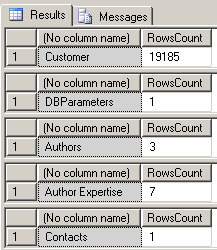SQL Cursor Example - List Count of Rows in All Tables in Database using SQL Server Cursor
In this document, sql developers will find a SQL cursor example t-sql code to list number of rows (record counts) in all user tables in a MS SQL Server database.
Note that with the T-SQL enhancements introduced with MS SQL Server 2005 and MS SQL Server 2008, developers and database administrators can find ways to avoid using SQL Server cursor in their sql codes in their jobs.
Do not use frequently sql cursor in production system during high load times. SQL cursors if not done in the correct declaration can effect the performance of database applications in negative manner.
So if possible prevent developers use transact-sql cursor in their sql scripts.
If you want more on SQL Server Cursor and find more sql cursor sample, you can go to sql tutorial How to Create and Use a Sample SQL Cursor and T-SQL Cursor Code.
In the following SQL Server cursor, you will first notice the cursor declaration in sql script.
You can declare sql cursor using DECLARE cursorname CURSOR syntax.
This sample sql cursor is build over a list of user tables defined in a database, and is used for listing the count of rows in each database table.
Since for each table a sql select query is build and executed seperately, the sql cursor or the loop for running select task for each table consumes considerable resource.
Do not forget, sql engine is built and optimized for batch processes not for single row processes. So if possible avoid from using sql cursor in sql codes.
SQL Cursor Example
Here is a sql cursor example :
DECLARE @TableName sysname
DECLARE @SQL nvarchar(max)
DECLARE tables_cursor CURSOR FAST_FORWARD
FOR
SELECT name FROM sys.tables
OPEN tables_cursor
FETCH NEXT FROM tables_cursor INTO @TableName
WHILE @@FETCH_STATUS = 0
BEGIN
SELECT @SQL =
'SELECT ''' + @TableName + ''', COUNT(*) as RowsCount ' +
'FROM [' + @TableName + ']'
EXEC SP_EXECUTESQL @SQL
FETCH NEXT FROM tables_cursor INTO @TableName
END
CLOSE tables_cursor
DEALLOCATE tables_cursor
And when I execute the above sample sql cursor code on one of my SQL Server databases, I get the following sample t-sql cursor output :
The above cursor is declared as FAST_FORWARD which is faster than other cursor declaration types.
Additional SQL Cursor Tutorials and T-SQL Cursor Examples
You can find more sql cursor tutorials and sql cursor example at the following articles :
How to Create and Use a Sample SQL Cursor and T-SQL Cursor Code
T-SQL Cursor Example Code
You can find more on cursor types in sql on MSDN.
I hope you find this sql cursor example useful.

